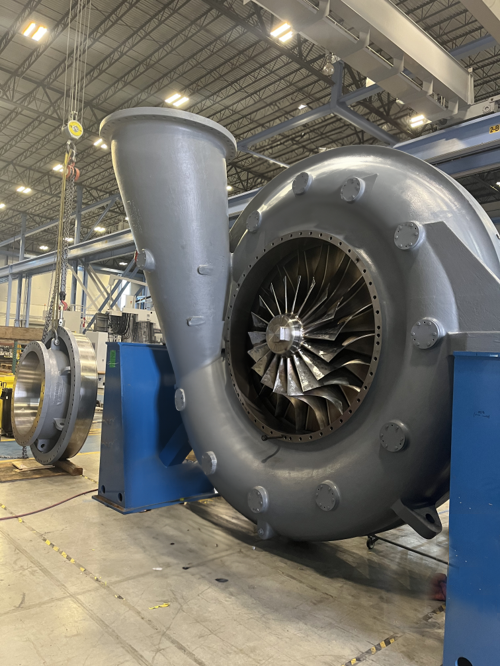RMS Replaces Blower on D54 Centrifugal Compressor Using Virtual Assembly
RMS performed a digital overlay using a real-time scanner to prepare for the virtual assembly process before replacing the blower.
Engineering and metrology teams at Rotating Machinery Services (RMS) performed a drop-in blower replacement on an AC Compressor-brand D54 centrifugal compressor. The teams scanned the current blower during operation at RMS’ Pearland Works facility, revealing critical geometries such as suction and discharge nozzles and baseplate feet without interfering with the customer’s production schedule.
"I am proud of our team's approach to the AC Compressor D54 centrifugal compressor replacement project," said Kraig Simpson, Vice President of Technology, RMS. "By leveraging advanced real-time scanning and virtual assembly technologies, we have not only streamlined the integration process but also set new benchmarks for efficiency and precision in the industry. This project exemplifies how we are changing the way we view turbomachinery maintenance, pushing the boundaries of what is possible and paving the way for more proactive, data-driven, and seamless maintenance solutions."
The digital overlay provided by the real-time scan prepared RMS for the virtual assembly process in the Prevu3D platform. A virtual overlay of the replacement blower was compared to the original scan data, allowing engineers to understand how the component would fit into the system upon installation. The scan comparison established the need for precise baseplate machining for a seamless fit on the new blower—RMS partnered with a field machining company to optimize baseplate geometry for efficient installation and optimal shaft end alignment.
Blower for D54 centrifugal compressor; Image Credits: RMS

The overlay also showed differences in discharge nozzle heights between the existing blower and the replacement part. Engineers used metrology data to fabricate a transition spool, addressing the height variation.
In January 2024, RMS partnered with a plastics manufacturing customer to upgrade and overhaul an AC compressor DH single-stage centrifugal compressor. The customer enlisted RMS’s services to replace the compressor’s water seals with dry gas seals. RMS conducted the engineering and build of the conversion process, including the control panel for the dry gas seal skid, compressor overhaul, dry gas seal installation, and pre-installation testing at the customer’s site. A spare seal housing and spare rotor were also supplied by RMS.
RMS performed the compressor overhaul at the company’s Pearland Works facility. The company tested the control panel at the customer’s site and completed a casing hydro test and gas leak test at RMS Pearland Works. Upon completion of the dry gas seal upgrade, the field service team worked at the customer site to finish the project in two phases.
The first phase removed the older compressor skid from the site to make room for the upgraded unit. The second phase involved the installation of the new compressor, controls system, and dry gas seal panel. The RMS team also accommodated the site’s piping configuration to accept a drop-in replacement.
The company also assisted a refining customer in overhauling an AC Compressor VH-405 centrifugal compressor. The team conducted the overhaul operation and delivered the finished product ahead of time. Shop staff, RMS engineering, and project management were on-site to perform the compressor overhaul operation.
AC Compressor’s V-405 model was sent to RMS after containment in the customer’s laydown yard for several years. Due to the outdoor storage, the centrifugal compressor was heavily corroded and filled with water and debris that required removal before further inspection. The compressor internals were rusted and required blasting to restore the metal finish.
Upon inspection, RMS identified several cracks along the diaphragm split lines which had to be welded to meet RMS standards. The cracks were welded with a temper bead technique, which eliminates the need for post-weld heat treatment and reduces the turnaround time for the repair. RMS removed the balance piston seal insert to clean and scan the component for a future fabrication drawing.